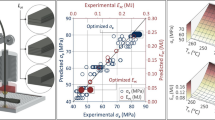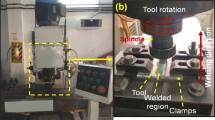Abstract
A systematic approach was presented to develop the empirical model for predicting the ultimate tensile strength of AA5083-H111 aluminum alloy which is widely used in ship building industry by incorporating friction stir welding (FSW) process parameters such as tool rotational speed, welding speed, and axial force. FSW was carried out considering three-factor five-level central composite rotatable design with full replications technique. Response surface methodology (RSM) was applied to developing linear regression model for establishing the relationship between the FSW process parameters and ultimate tensile strength. Analysis of variance (ANOVA) technique was used to check the adequacy of the developed model. The FSW process parameters were also optimized using response surface methodology (RSM) to maximize the ultimate tensile strength. The joint welded at a tool rotational speed of 1 000 r/min, a welding speed of 69 mm/min and an axial force of 1.33 t exhibits higher tensile strength compared with other joints.
Similar content being viewed by others
References
DAWES C J, THOMAS W M. Friction stir joining of aluminum alloys [C]// TWI Bulletin. The Welding Institute, 1995: 124.
COLLIGAN K J. Frictions stir welding for ship construction [M]. Harrisburg, PA: Concurrent Technologies Corporation, 2004: 1–6.
PEEL M, STEUWER A, PREUSS M, WITHERS P J. Microstructure mechanical properties and residual stresses as a function of welding speed in aluminum AA5083 friction stir welds [J]. Acta Materialia, 2003, 51(16): 4791–4801.
HAN M S, LEE S J, PARK J C, KO S C, WOO Y B, KIM S J. Optimum condition by mechanical characteristic evaluation in friction stir welding for 5083-O Al alloy [J]. Transaction of Nonferrous Metals Society of China, 2009, 19(1): 17–22.
LEAL R, LOUREIRO A. Defects formation in friction stir welding of aluminium alloys [J]. Advanced Material Forum II, 2004, 455/456: 299–302.
CHEN Y C, LIU H, FENG J. Friction stir welding characteristics of different heat-treated-state 2219 aluminium alloy plates [J]. Material Science Engineering A, 2006, 420(1/2): 21–25.
GRUM J, SLABE J M. The use of factorial design and response surface methodology for fast determination of optimal heat treatment conditions of different Ni-Co-Mo surfaced layers [J]. Journal of Materials Processing Technology, 2004, 155(30): 2026–2032.
GUNARAJ V, MURUGAN N. Application of response surface methodology for predicting weld bead quality in submerged arc welding of pipes [J]. Journal of Material Processing Technology, 1999, 88: 266–275.
MANONMANI K, MURUGAN N, BUVANASEKARAN G. Effect of process parameters on the weld bead geometry of laser beam welded stainless steel sheets [J]. International Journal of Joining Materials, 2005, 17(4): 103–109.
BALASUBRAMANIAN M, JAYABALAN V, BALASUBRAMANIAN V. Developing mathematical models to predict tensile properties of pulsed current gas tungsten arc welded Ti-6Al-4V alloy [J]. Materials and Design, 2008, 29(1): 92–97.
PALANI P K, MURUGAN N. Optimization of weld bead geometry for stainless steel claddings deposited by FCAW [J]. Journal of Materials Processing Technology, 2007, 190(1): 291–299.
PALANI P K, MURUGAN N. Sensitivity analysis for process parameters in cladding of stainless steel by flux cored arc welding [J]. Journal of Manufacturing Processes, 2006, 8(2): 90–100.
KARTHIKEYAN R, BALASUBRAMANIAN V. Predictions of the optimized friction stir spot welding process parameters for joining AA2024 aluminum alloy using RSM [J]. International Journal of Advanced Manufacturing Technology, 2010, 51: 173–183.
COLLIGAN J, PAUL J, KONKOL, JAMES J, FISHER P, JOSEPH R. Friction stir welding demonstrated for combat vehicle construction [J]. Welding Journal, 2003, 82(3): 1–6.
ELANGOVAN K, BALASUBRAMANIAN V, VALLIAPPAN M. Influences of tool pin profile and axial force on the formation of friction stir processing zone in AA6061 aluminium alloy [J]. International Journal of Advanced Manufacturing Technology, 2008, 38: 285–295.
TIEN C L, LIN S W. Optimization of process parameters of titanium dioxide films by response surfaces methodology [J]. Optics Communication, 2006, 266(2): 574–581.
PHILLIP J R. Taguchi techniques for quality engineering [M]. New York: Mc Graw-Hill, 1988: 114.
Author information
Authors and Affiliations
Corresponding author
Rights and permissions
About this article
Cite this article
Palanivel, R., Koshy Mathews, P. Prediction and optimization of process parameter of friction stir welded AA5083-H111 aluminum alloy using response surface methodology. J. Cent. South Univ. Technol. 19, 1–8 (2012). https://doi.org/10.1007/s11771-012-0964-y
Received:
Accepted:
Published:
Issue Date:
DOI: https://doi.org/10.1007/s11771-012-0964-y




